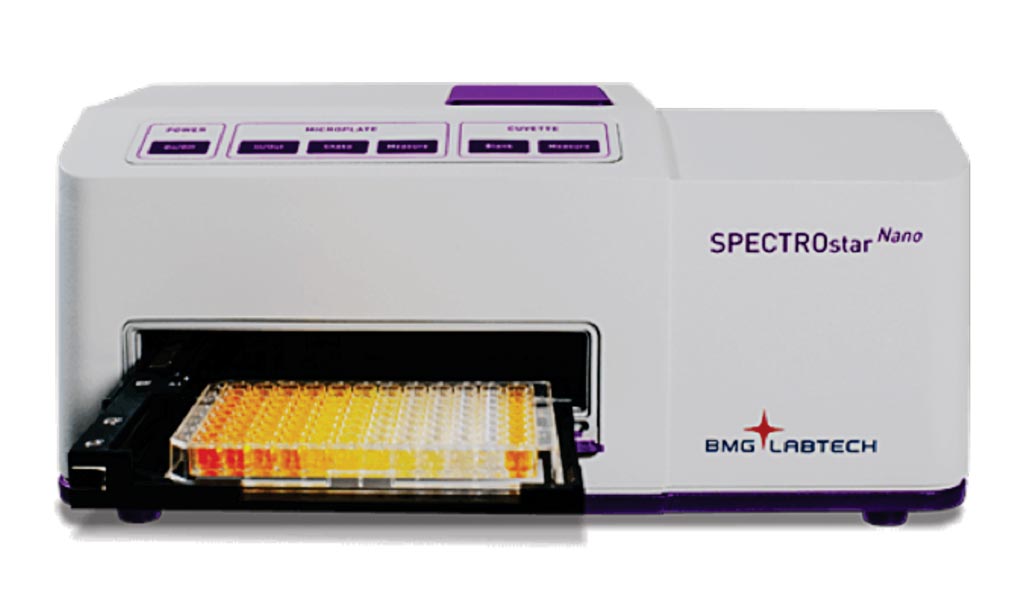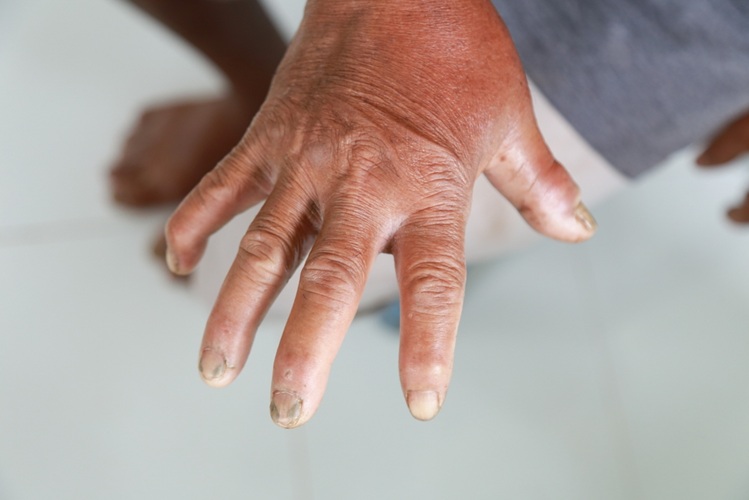Recombinant Capture Molecule Used for Viral Disease Diagnosis
|
By LabMedica International staff writers Posted on 17 Apr 2019 |

Image: The SPECTROstar Nano Absorbance plate reader with cuvette port (Photo courtesy of BMG Labtech).
Crimean-Congo hemorrhagic fever (CCHF) is an infectious disease endemic in a variety of countries in southeastern Europe, the Middle East, Asia, and Africa. The virus (CCHFV) transmission occurs via the bite of an infected tick and also by close contact with body fluids of infected persons or livestock.
The Zika Virus (ZIKV) is an arbovirus that belongs to the Flavivirus genus and infection follows the bite of an infected Aedes mosquito, and it presents with mild flulike disease symptoms; asymptomatic infection is frequent. A ZIKV infection occurring during the first trimester of pregnancy significantly increases the probability for the fetus to develop microcephaly, a severe and disabling malformation of the brain.
An international team of scientists working with the Bernhard Nocht Institute for Tropical Medicine (Hamburg, Germany) have demonstrate the potential of the bacterially expressed extracellular immunoglobulin-like domain of the human FcμR (HsFcμR-Igl) as a capture molecule for IgM-specific serological testing. As model systems, they chose two viral pathogens, the CCHFV and the ZIKV. In 2015, both were identified as high-risk emerging pathogens by the World Health Organization (WHO, Geneva, Switzerland) likely to cause major epidemics and thus needing urgent investigation and development attention.
His-tagged HsFcμR-Igl was expressed in Escherichia coli and purified by affinity chromatography, oxidative refolding, and size-exclusion chromatography. Specific binding of HsFcμR-Igl to IgM/antigen immune complexes (ICs) was confirmed, and two prototypic enzyme-linked immunosorbent assays (ELISAs) for the detection of anti-CCHFV and anti-ZIKV IgM antibodies were developed. Thereby, patient sera and virus-specific recombinant antigens directly labeled with horseradish peroxidase (HRP) were co-incubated on HsFcμR-Igl-coated ELISA plates. Bound ICs were quantified by measuring turnover of a chromogenic HRP substrate. For all ELISAs, the HRP reaction product was quantified by measuring absorbance (A) at 450 nm and 620 nm on a Spectrostar Nano ELISA reader.
Assay validation was performed using paired serum samples from 15 Kosovar patients with a polymerase chain reaction (PCR)-confirmed CCHFV infection and 28 Brazilian patients with a PCR-confirmed ZIKV infection, along with a panel of a priori CCHFV/ZIKV-IgM-negative serum samples. Both ELISAs were highly reproducible. Sensitivity and specificity were comparable with or even exceeded in-house gold standard testing and commercial kits. Furthermore, latex beads coated with HsFcμR-Igl aggregated upon co-incubation with an IgM-positive serum and HRP-labeled antigen but not with either component alone, revealing a potential for use of HsFcμR-Igl as a capture molecule in aggregation-based rapid tests.
The authors concluded that recombinant HsFcμR-Igl is a versatile capture molecule for IgM/antigen ICs of human and animal origin and can be applied for the development of both plate- and bead-based serological tests. The study was published in the February 2019 issue of the journal Clinical Chemistry.
Related Links:
Bernhard Nocht Institute for Tropical Medicine
World Health Organization
The Zika Virus (ZIKV) is an arbovirus that belongs to the Flavivirus genus and infection follows the bite of an infected Aedes mosquito, and it presents with mild flulike disease symptoms; asymptomatic infection is frequent. A ZIKV infection occurring during the first trimester of pregnancy significantly increases the probability for the fetus to develop microcephaly, a severe and disabling malformation of the brain.
An international team of scientists working with the Bernhard Nocht Institute for Tropical Medicine (Hamburg, Germany) have demonstrate the potential of the bacterially expressed extracellular immunoglobulin-like domain of the human FcμR (HsFcμR-Igl) as a capture molecule for IgM-specific serological testing. As model systems, they chose two viral pathogens, the CCHFV and the ZIKV. In 2015, both were identified as high-risk emerging pathogens by the World Health Organization (WHO, Geneva, Switzerland) likely to cause major epidemics and thus needing urgent investigation and development attention.
His-tagged HsFcμR-Igl was expressed in Escherichia coli and purified by affinity chromatography, oxidative refolding, and size-exclusion chromatography. Specific binding of HsFcμR-Igl to IgM/antigen immune complexes (ICs) was confirmed, and two prototypic enzyme-linked immunosorbent assays (ELISAs) for the detection of anti-CCHFV and anti-ZIKV IgM antibodies were developed. Thereby, patient sera and virus-specific recombinant antigens directly labeled with horseradish peroxidase (HRP) were co-incubated on HsFcμR-Igl-coated ELISA plates. Bound ICs were quantified by measuring turnover of a chromogenic HRP substrate. For all ELISAs, the HRP reaction product was quantified by measuring absorbance (A) at 450 nm and 620 nm on a Spectrostar Nano ELISA reader.
Assay validation was performed using paired serum samples from 15 Kosovar patients with a polymerase chain reaction (PCR)-confirmed CCHFV infection and 28 Brazilian patients with a PCR-confirmed ZIKV infection, along with a panel of a priori CCHFV/ZIKV-IgM-negative serum samples. Both ELISAs were highly reproducible. Sensitivity and specificity were comparable with or even exceeded in-house gold standard testing and commercial kits. Furthermore, latex beads coated with HsFcμR-Igl aggregated upon co-incubation with an IgM-positive serum and HRP-labeled antigen but not with either component alone, revealing a potential for use of HsFcμR-Igl as a capture molecule in aggregation-based rapid tests.
The authors concluded that recombinant HsFcμR-Igl is a versatile capture molecule for IgM/antigen ICs of human and animal origin and can be applied for the development of both plate- and bead-based serological tests. The study was published in the February 2019 issue of the journal Clinical Chemistry.
Related Links:
Bernhard Nocht Institute for Tropical Medicine
World Health Organization
Latest Immunology News
- Stem Cell Test Predicts Treatment Outcome for Patients with Platinum-Resistant Ovarian Cancer
- Machine Learning-Enabled Blood Test Predicts Immunotherapy Response in Lymphoma Patients
- Post-Treatment Blood Test Could Inform Future Cancer Therapy Decisions
- Cerebrospinal Fluid Test Predicts Dangerous Side Effect of Cancer Treatment
- New Test Measures Preterm Infant Immunity Using Only Two Drops of Blood
- Simple Blood Test Could Help Choose Better Treatments for Patients with Recurrent Endometrial Cancer
- Novel Analytical Method Tracks Progression of Autoimmune Diseases
- 3D Bioprinted Gastric Cancer Model Uses Patient-Derived Tissue Fragments to Predict Drug Response
- Blood Test for Fungal Infections Could End Invasive Tissue Biopsies
- Cutting-Edge Microscopy Technology Enables Tailored Rheumatology Therapies
- New Discovery in Blood Immune Cells Paves Way for Parkinson's Disease Diagnostic Test
- AI Tool Uses Routine Blood Tests to Predict Immunotherapy Response for Various Cancers
- Blood Test Can Predict How Long Vaccine Immunity Will Last
- Microfluidic Chip-Based Device to Measure Viral Immunity
Channels
Clinical Chemistry
view channel
New Method Uses Pulsed Infrared Light to Find Cancer's 'Fingerprints' In Blood Plasma
Cancer diagnoses have traditionally relied on invasive or time-consuming procedures like tissue biopsies. Now, new research published in ACS Central Science introduces a method that utilizes pulsed infrared... Read more
Carbon Nanotubes Help Build Highly Accurate Sensors for Continuous Health Monitoring
Current sensors can measure various health indicators, such as blood glucose levels, in the body. However, there is a need to develop more accurate and sensitive sensor materials that can detect lower... Read moreMolecular Diagnostics
view channel
Gene-Based Blood Test Accurately Predicts Tumor Recurrence of Advanced Skin Cancer
Melanoma, an aggressive form of skin cancer, becomes extremely difficult to treat once it spreads to other parts of the body. For patients with metastatic melanoma tumors that cannot be surgically removed... Read more
Blood Test Could Identify Patients at Risk for Severe Scleroderma
Systemic sclerosis, also known as scleroderma, causes the hardening of the skin and connective tissues. In many cases, the disease can also damage vital organs, including the heart, kidneys, lungs, and... Read moreHematology
view channel
New Scoring System Predicts Risk of Developing Cancer from Common Blood Disorder
Clonal cytopenia of undetermined significance (CCUS) is a blood disorder commonly found in older adults, characterized by mutations in blood cells and a low blood count, but without any obvious cause or... Read more
Non-Invasive Prenatal Test for Fetal RhD Status Demonstrates 100% Accuracy
In the United States, approximately 15% of pregnant individuals are RhD-negative. However, in about 40% of these cases, the fetus is also RhD-negative, making the administration of RhoGAM unnecessary.... Read moreMicrobiology
view channel
Handheld Device Delivers Low-Cost TB Results in Less Than One Hour
Tuberculosis (TB) remains the deadliest infectious disease globally, affecting an estimated 10 million people annually. In 2021, about 4.2 million TB cases went undiagnosed or unreported, mainly due to... Read more
New AI-Based Method Improves Diagnosis of Drug-Resistant Infections
Drug-resistant infections, particularly those caused by deadly bacteria like tuberculosis and staphylococcus, are rapidly emerging as a global health emergency. These infections are more difficult to treat,... Read more
Breakthrough Diagnostic Technology Identifies Bacterial Infections with Almost 100% Accuracy within Three Hours
Rapid and precise identification of pathogenic microbes in patient samples is essential for the effective treatment of acute infectious diseases, such as sepsis. The fluorescence in situ hybridization... Read morePathology
view channel
New Error-Corrected Method to Help Detect Cancer from Blood Samples Alone
"Liquid biopsy" technology, which relies on blood tests for early cancer detection and monitoring cancer burden in patients, has the potential to transform cancer care. However, detecting the mutational... Read more
"Metal Detector" Algorithm Hunts Down Vulnerable Tumors
Scientists have developed an algorithm capable of functioning as a "metal detector" to identify vulnerable tumors, marking a significant advancement in personalized cancer treatment. This breakthrough... Read more
Novel Technique Uses ‘Sugar’ Signatures to Identify and Classify Pancreatic Cancer Cell Subtypes
Pancreatic cancer is often asymptomatic in its early stages, making it difficult to detect until it has progressed. Consequently, only 15% of pancreatic cancers are diagnosed early enough to allow for... Read moreTechnology
view channel
Pain-On-A-Chip Microfluidic Device Determines Types of Chronic Pain from Blood Samples
Chronic pain is a widespread condition that remains difficult to manage, and existing clinical methods for its treatment rely largely on self-reporting, which can be subjective and especially problematic... Read more
Innovative, Label-Free Ratiometric Fluorosensor Enables More Sensitive Viral RNA Detection
Viruses present a major global health risk, as demonstrated by recent pandemics, making early detection and identification essential for preventing new outbreaks. While traditional detection methods are... Read moreIndustry
view channel
Cepheid and Oxford Nanopore Technologies Partner on Advancing Automated Sequencing-Based Solutions
Cepheid (Sunnyvale, CA, USA), a leading molecular diagnostics company, and Oxford Nanopore Technologies (Oxford, UK), the company behind a new generation of sequencing-based molecular analysis technologies,... Read more
Grifols and Tecan’s IBL Collaborate on Advanced Biomarker Panels
Grifols (Barcelona, Spain), one of the world’s leading producers of plasma-derived medicines and innovative diagnostic solutions, is expanding its offer in clinical diagnostics through a strategic partnership... Read more






















